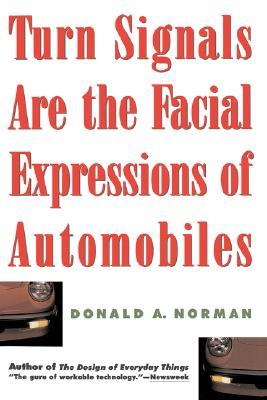A few months ago I went out into the Arizona desert to take photographs for a book of natural history I am writing. I had with me an expensive, late-model Japanese camera that might be advertised as “idiot-proof,” had the manufacturer been less guarded in the tone of its publicity. In fact, the camera turned out to be, if anything, too idiot-proof; it refused to allow me to override its settings to underexpose or overexpose any given shot, a vexing enough situation given the day’s alternating periods of bright sunlight and black storm clouds. The result was a series of photographs that were competent enough but less than dramatic, far inferior to those an old Brownie would have delivered.
With many advances in technology there follows a diminution of quality. Or so Donald Norman sets out to demonstrate in Turn Signals Are the Facial Expressions of Automobiles, which opens with an automatic-camera tale much like my own. The principal difference is that Norman, a professor of cognitive science at the University of California, San Diego, has both the technical wherewithal and the leisure to contemplate why grappling with unfriendly objects should fill so many of our hours. He’s determined to change this sorry state of affairs.
Norman’s excursuses on the grand question of bad design filled his book The Psychology of Everyday Things (1988), a curmudgeonly look at the construction of common objects. Turn Signals doesn’t break much new ground, but instead supplements the author’s earlier work. He announces at the outset his intention to scrutinize all new artifacts that might make our thinking and quotidian acting a little easier, and his commonsensical forays make for stimulating reading indeed—especially because their subjects, everyday objects around the house, are so familiar that we tend to take them and the headaches they occasion for granted. He finds most of those new artifacts wanting.
“Why,” Norman asks, “does a simple thing like a door need an instruction manual in the form of the words ‘push’ or ‘pull’?” A well-designed object, he argues, is self-explanatory. But, he continues, well-designed objects are increasingly rare; the present commodity culture places a higher value on esthetics than it does on utility, even with such things as cordless screwdrivers and dresser drawers and kitchen cabinets. Being concerned with “art,” many designers don’t seem to take into account what it is that people actually do with the things they concoct.
For that reason, perhaps, few objects are standardized. In a diverting exercise, Norman wanders around his home counting clocks and electric motors (he stops cataloging when he begins to wander onto the number of batteries he owns), pausing to pillory the makers of videocassette recorders, coffee makers, microwave ovens, and so forth. (It may be uncharitable to suggest that he doesn’t really need all those trinkets.) Why, he wonders, must he be required to reset all those clocks whenever the power goes off during an electrical storm? Rather than go low tech, Norman arrives at a characteristically elegant solution: some designer somewhere, he ventures, ought to develop a master clock that communicates with all other electric clocks in a home; one that, when reset, synchronizes its slave units.
Norman’s approach is trial by digression. Every now and again the chapters of his book seem connected only by the thinnest of threads—another instance ahem of too-subtle design. For the most part, however, the seeming discontinuities add up. He ponders why automobile dashboards, which bear critical controls, should be more poorly designed than turn and brake signals, which serve only to convey meaning to other drivers—whence the title of this slender book. He ranges widely from culture to culture to determine whether the American use of the refrigerator door as a family message center is a modern universal—and, when he discovers that it is not, cries out for some designer to find a more elegant solution to our communicative needs than the lowly refrigerator magnet. He skewers the unprovably dogmatic notion that humans use only one percent of their brainpower, remarking that in any event the other 99 percent is probably given over to redundant mechanisms that allow us to keep two thoughts going at the same time while still remembering to breathe.
Most compellingly, Norman discusses the consequences of slovenly thinking and its bastard offspring, slovenly design. He remarks, “When I am told that more than half the world’s accidents— home and industrial—are blamed on the people involved, I get very, very suspicious indeed.” Airline accidents are routinely blamed on pilot error; Three Mile Island and Chernobyl were pegged on inattentive operators; and hospitals across the nation are daily overrun by the victims of technologically induced woes. For Norman, the makers of the knobs and panels and other doodads that cannot help but confuse those who confront them are the source of many of the world’s ills, and if he sometimes wanders too deeply into conspiracy theory, well, so be it.
One need not be a technocrat, nor even especially interested in technological matters, to enjoy Norman’s arguments, which more and more come to rank alongside the best of Lewis Mumford and Buckminster Fuller. The question remains: will the design of everyday things improve? It would be comforting to think that at laboratories and galleries across the technological world, designers are pouring over Turn Signals, but Norman remains a skeptic. “I have seen some of the technology of the future and it looks suspiciously like that of the past, except with fancier buttons and displays, and more elaborate hardware.” For all that, he remains fixed on the quest, and he closes with a disquisition on the old English proverb, “If you can’t stand the heat, get out of the kitchen.”
Rubbish, he says. If that’s the case, the thing to do is redesign the kitchen.
[Turn Signals Are the Facial Expressions of Automobiles, by Donald A. Norman (Reading, Massachusetts: Addison-Wesley) 205 pp., $21.95]

Leave a Reply